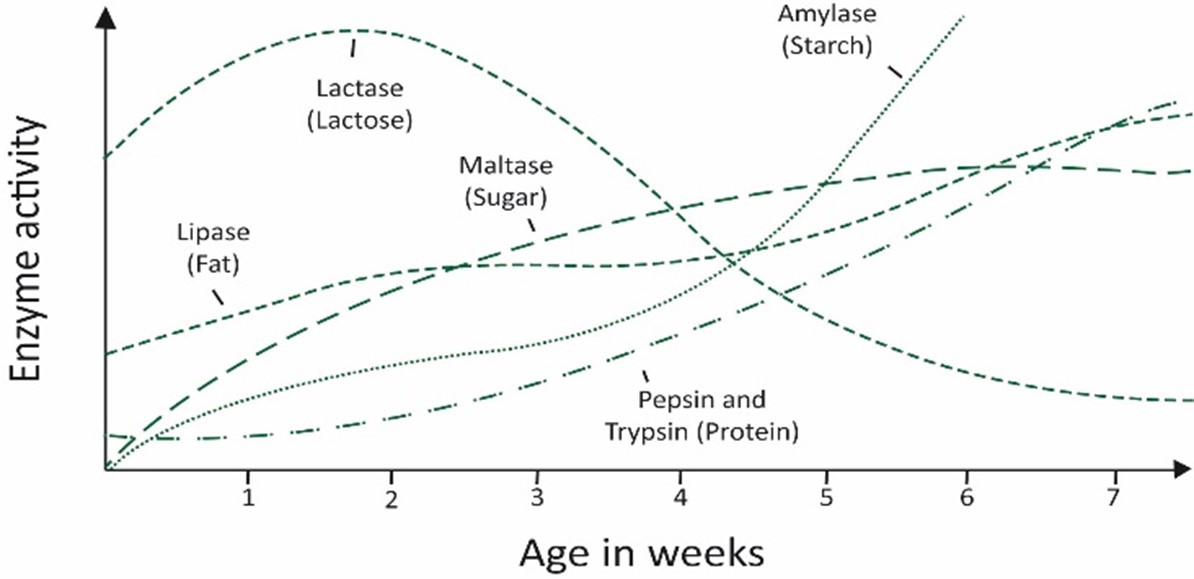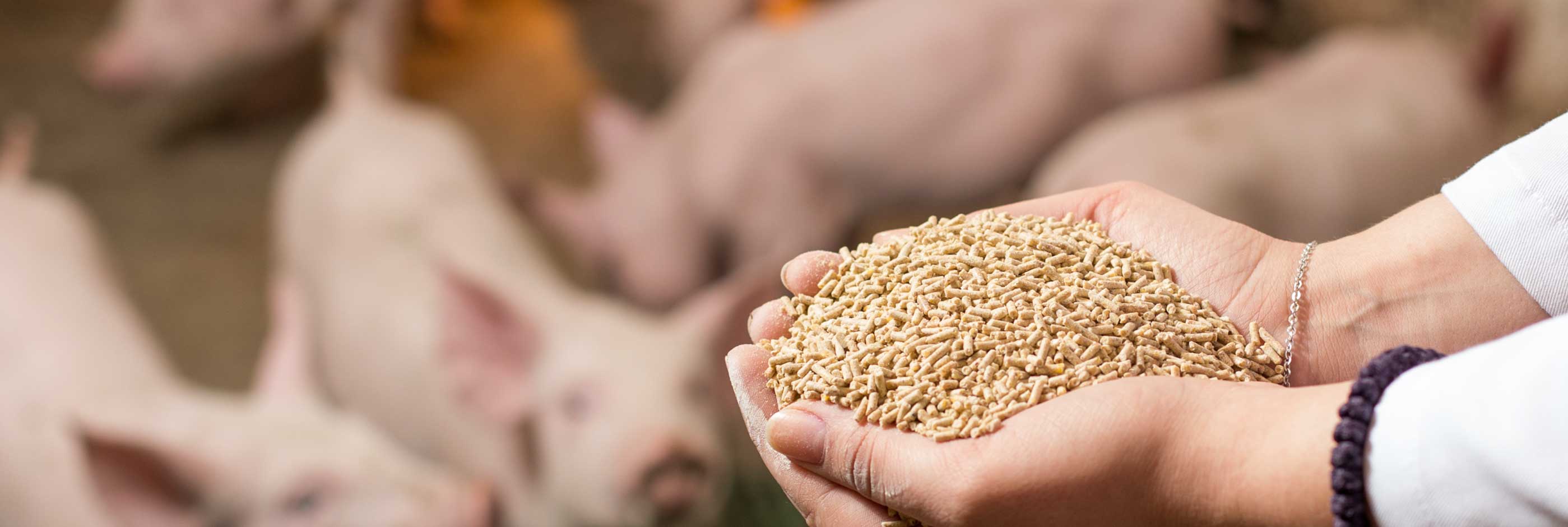Young animal nutrition: protein digestion
Young and growing animals differ largely from mature animals when it comes to their nutritional requirements. Young animals mature and develop at a fast pace, gaining muscle and growing bones while their brains and nervous system also develop. This requires a high concentration of nutrients, specifically protein and calcium. Until young animals are weaned, all their nutritional requirements are met by their mother’s milk or a milk replacement formula (mammals). When transitioning to solid feed, it is important to find a diet and feeding regimen that continues to support proper growth and development.
A well-balanced diet will include a diversity of ingredients that provide proteins and a specific amino acid profile. When consumed and digested, protein in the diet is broken down into individual amino acids in the gastrointestinal tract. Certain amino acids are required by animals to form proteins as they cannot synthesize them themselves. These amino acids are referred to as essential amino acids. Especially young animals struggle to obtain sufficient AA’s from their diets. Young animals are challenged on two fronts when trying to ensure the required AA’s:
Not fully developed at birth, the digestive tract of young animals cannot digest protein as well as in fully developed animals. (Figure 1.) The gut maturation takes time depending on species:
- Chicks – 7-10 days of age
- Piglets – 10 weeks of age
- Calves – 6 months of age
Amino acid requirement of young animals is higher per energy unit than during later growth stages, resulting in a higher concentration of protein in feed for young animals. (Table 1.) One factor behind this relatively high requirement in young animals is hypertrophy, the fact that organs and muscle growth in young animals is high relative to e.g. fat growth. (Muscle and organ growth require more AA than energy opposite fat growth). For example, the intestinal tract of a weaned piglet grows from 4 meters around weaning to 15 meters at 11 weeks of age; this equals 14 cms per day!
Understanding hypertrophy or early growth of muscle in young animals, helps understand the importance of feeding animals the required AA as early as possible.


Table 1. Protein in diets from cereals respectively protein ingredients
A large part of the protein must come from the protein ingredients in the diets, even in the diets with a large inclusion of cereals. This emphasizes the importance of quality of the protein ingredients used. With a high requirement for protein, as in piglet and young chick feed, there is less room for cereals and the inclusion of protein ingredients increase. Consequently, young animal feed has the highest concentration of protein and hence, the highest inclusion of protein ingredients, despite the fact that they struggle the most handling it.
The growth process also requires a higher level of energy in the diet. Higher dietary protein will help contribute to this need, but slightly increased amounts of fat concentrations (as compared to adult formulas) are also useful to accomplish a higher energy density. Feeding directions can also accomplish greater energy intake by offering a greater volume or feeding an unlimited quantity.
When choosing protein sources, several inputs are important:
- Protein concentration
- Digestibility
- Amino acid profile
- Antinutritional factors, ANF’s (depending on animal age and species)
- Other nutrient specs. (Chemical composition)
- Price
Some protein sources are mainly for older animals and some mostly for young animals. Protein sources not often considered for young animals are typically compromised in one or several of the following ways:
- High fibre content
- High content of ANF’s
- Poor AA profile
- Low digestibility
- Poor palatability
- Downright toxicity
Animal vs vegetable proteins
Historically animal proteins were used in young animal feed as they have a valuable AA profile and a good digestibility. Compared to vegetable proteins, animal proteins have no anti nutrients making them highly digestible.
With the recent (upcoming) bans on the use of in-feed antibiotics and ZnO it becomes difficult to maintain high levels of protein in the diets for young animals. Additionally, it is well known that animal proteins are predisposing factors to intestinal disorders like for instance Clostridium infections in birds in antibiotic-free poultry production. Furthermore, many animal proteins are relatively expensive, either because of scarceness or alternative use in human or pet food production.
Vegetable protein ingredients contain components which may restrict their inclusion in young animal feed. Anti-nutritional factors interfering directly with the gut and digestion or microbiota are found in many vegetable proteins like soy, peas and other legumes (trypsin inhibitors, antigenic proteins). Also, potato protein concentrate displays some of these ANF’s (trypsin inhibitors, solanine). Other components may negatively affect the microbiota of the animal like certain oligosaccharides in peas and soy -or faba beans. Vegetable proteins from starch production; corn gluten and wheat gluten are insufficient to compliment the AA profile of existing cereals in the diet. Furthermore, they contain prolamins, which damage gut integrity leading to a so-called leaky gut.
The antinutritional factors in several protein ingredients may be recognized by the intestinal innate immune system in young animals leading to sterile chronic inflammations, in the absence of any infection, which are energy draining immune responses that compromise the proper organ development and animal growth. Thus, the reduction of the level of those antinutritional factors in the starter diets using clean vegetable protein sources is an effective strategy to minimize the activation of that type of feed-induced immune reactions at an early age, avoiding negative effects on performance later in life.
High nutritional requirements for ultra-rapid growth
Young farm animals have both high nutritional requirements for ultra-rapid growth and an immature and fragile digestive system that limits nutrient absorption. The formulation and distribution of feed targeting this dual nutritional issue is strategic for the breeder. Particular care must be taken in the choice of protein sources. Market commodities such as protein meals, if they are suitable for older animals, are poorly tolerated and insufficiently valued by the youngest. It is important to select protein
What are ANF's?
In soybeans, ANFs cover a range of substances that provide important protection against mold, bacteria and over-consumption by wild animals. However in feed, they represent a health risk.
Many scientific studies have documented their harmful effect on the development and functionality of the gut, reducing the utilization of nutrients and compromising growth.
But it is possible to minimize the factors that are most critical to the growth and development of piglets - the result being a high-quality soy protein and improved animal health.
Sequence contains no elements
Sequence contains no elements

